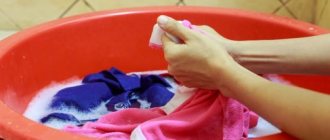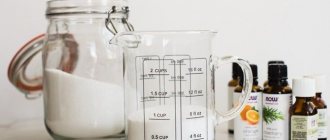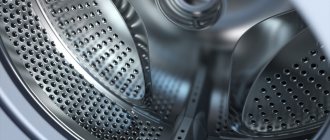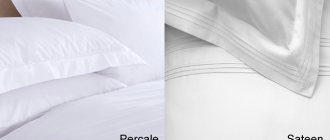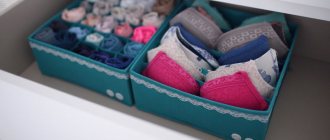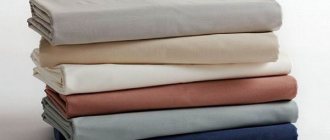What to do if you don't have bleach?
10 life hacks on how to make things white if you don't have bleach
- Boiling Are you still boiling? ...
- Hydrogen peroxide Hydrogen peroxide works well for yellowing white things. ...
- Baking soda Many people know about the endless possibilities of soda. ...
- Table salt You can try to fight for the whiteness of fabric using table salt. ...
- Laundry soap …
- Vinegar …
- Potassium permanganate...
- Blue
14 Dec. 2022
How to Use Fabric Bleach in the Washing Machine
In most cases, it is necessary to restore freshness to women's blouses, shirts, underwear and socks. Simply put, those things that end up in the washing machine more often than others. It is easy to wash and bleach small items by hand, using the product according to the instructions. But curtains or bedding will have to be washed in the machine.
For adding bleach to the washing machine, certain models (Lg, Indesit, etc.) have special trays with a triangle on them. In most cases, such a part is removable and is placed in the compartment for washing powders used in pre-washing. As a rule, such a compartment is marked with the letter A or the number I. This option is best suited for optical or oxygen compounds that are not included in detergents.
Housewives warn that it is not always recommended to pour White into the washing machine. First of all, you should carefully study the operating requirements for your washing machine. If the manufacturer allows the use of chlorine preparations, this means that all the main components of the machine are made of chlorine-resistant materials.
Still, where should you pour the bleach? The chlorine composition must be added in such a way that a minimum number of parts of the washing machine come into contact with it. Pour the product according to the indicated dosage, dissolve it in two to three liters of liquid, which is poured directly into the drum, along with the loaded items.
Before the process begins, things must be sorted by white and colored shades and by type of material. Products with metal decorations, rivets, zippers or buttons are not subject to bleaching. The fact is that metal elements can darken, and the material around them will turn yellow.
If the instruction manual for your washing machine prohibits adding chlorine bleach, then the clothes are first soaked for a maximum of an hour in water with bleach added to it, and only then sent to the machine.
Is it possible to mix whiteness and washing powder?
If you are doing a small wash, just pour a glass of white into the compartment located in the cuvette. You can add washing powder if necessary. If you pour bleach into the drum, you should definitely dilute it with a small amount of water. Such measures will prevent tissue damage.
Interesting materials:
How can a contractor refuse to perform a contract? How to seed a lawn? How to blue tulle? How to connect a flash drive to a tablet? How's Podtya? How to verify Western Union account? How to confirm the income of an individual entrepreneur? How to verify website ownership with Google? How to travel to the USA as a tourist? How is a mortgage paid off early?
Types of fabric bleaches
Today you can purchase whitening products in the form of powders or liquids, which are divided by composition and effect.
Oxygen-containing products
They are represented by solutions of hydrogen peroxide and contain certain components:
- stabilizers,
- active substances,
- optical brighteners,
- fragrance,
- regulators.
The main advantage of such bleaches is their use not only for linen and cotton, but also for wool, synthetics and even silk. Multi-colored fabrics will acquire brightness and freshness, dirt will be washed off completely, dyes will retain their properties.
Such bleaching agents can be poured, without fear of reaction of chemical compositions, with different washing powders. The compositions are hypoallergenic and do not cause harm to the body. In addition, such bleaches have a disinfecting effect.
Peroxide-based solutions are not durable and lose their beneficial qualities. For this reason, many advise using powder formulations.
Optical compositions
Another group of fabric bleaches that makes fabrics clean. But here it is necessary to note that the apparent white tint they give is created by the luminescent dyes contained in the composition.
This type of bleach is considered aggressive; the fabric begins to tear and turn yellow over time. It is not recommended to use it for items made of wool, silk, or synthetic materials.
Chlorine products
These drugs are sold in plastic containers that are resistant to chlorine. They easily return the original whiteness to cotton and linen items. When using this bleach, you must strictly follow the dosage specified by the manufacturer in the accompanying instructions. In order to avoid irritation of the respiratory system and the skin of the hands, before pouring the product, you should use a protective mask and rubber gloves.
Washing white clothes in an automatic machine
Almost every problem situation is easier to prevent in advance than to solve later. This statement also applies to snow-white clothes. It’s easier to properly care for it than to then, biting your elbows, think about how to remove the gray or yellowish tint of your favorite white T-shirt.
If you follow simple rules, you can easily extend the life of your favorite fabric product for a long time. Recommendations include:
- Laundry should be washed at a temperature of 30 degrees. For items containing synthetic fibers, the temperature should be less than the stated figure.
- When washing clothes, you should not throw in colored and white items at the same time. It often happens that a snow-white item is dyed a different color during the washing process with the help of an adjacent bright red T-shirt or deep blue T-shirt.
- All detergents must be used strictly according to the manufacturer's written instructions. There is no need to conduct unnecessary experiments.
- Synthetic items should not be dried in the sun.
- If, however, the color of a once-loved white item has faded and is no longer pleasing, then you can use a more radical method - bleaching.
You need to know this
To avoid problems with white items fading, always follow these rules:
- Wash white clothes and linens separately from colored ones.
- Cotton and linen are separate from wool and synthetics.
- The temperature for washing synthetic fabrics is no higher than 40 degrees.
- After washing, do not dry synthetics in direct sunlight.
- Frequent use of bleach weakens fabric fibers.
As you can see, the problem can be successfully solved at home. It will not be possible to always keep things perfectly white; after all, they get washed and worn out, this is inevitable. But it is quite possible to delay the appearance of yellowness and grayness. Take proper care of your products and notice a yellowish or gray tint in time, and then your products will remain snow-white for a long time.
Method 4. Mustard with potassium permanganate
There is no need to be afraid that mustard yellow will stain T-shirts or tank tops. To bleach things, throw mustard powder into water and immerse clothes in it for 2 hours. It is recommended to use this method specifically when washing silk and woolen items.
How to remove stains with potassium permanganate:
- Soap shavings are dissolved in boiled water.
- I pour potassium permanganate into another container, it turns out a light pink color.
- The resulting solutions are mixed, things are put in there, and the container is covered with a lid (film).
- Soak the laundry for 5-6 hours, then rinse several times. Clothes will become snow-white again.
Effective and fast-acting methods
The best option to bleach your favorite things is to use recipes made from natural ingredients that will not harm the fabric. Compositions based on components that can be found in every apartment quickly rid things of gray and yellow shades.
Laundry soap and Vanish
To whiten with this option, you need to purchase Vanish and a bar of laundry soap:
- Warm water is poured into the container.
- Adds soap crushed with a grater.
- Leave the laundry for 2.5 hours.
- Then the items are put into the washing machine and Vanish is added along with the powder.
Advice. To completely remove chemicals from fabric fibers, you need to rinse the laundry several times.
Laundry soap, ammonia and turpentine
A method using these three components is considered simple and effective:
- Water is poured into an enamel bucket and placed on fire.
- After the water boils, place the prepared clothes in it for 25 minutes.
- While the laundry is boiling, dissolve crushed soap in 500 ml of water, add 25 ml of ammonia and 35 ml of turpentine.
- After the appointed time, the fire is turned off.
- Once the water has cooled, add the mixture.
- The finished linen is left for 24 hours.
The product is considered reliable and non-hazardous for most types of fabrics, but only with rare use.
Features of bleaching laundry from different fabrics
An important factor in the effectiveness of washing and bleaching sheets and duvet covers is temperature.
- The “Cotton” program is set to whiten bed linen: satin, poplin, chintz, jacquard and other natural fabrics. The mode provides for a high washing temperature (90°C) with boiling, after which white linen shines with cleanliness and freshness, since boiling is one of the proven methods of bleaching.
- To obtain the best result, use the soak function with pre-wash.
- Silk linen is washed and bleached at a temperature not exceeding 40°C.
- For synthetic sheets there is a special “Synthetic” mode.
Using bleach to clean your washing machine
If the rules for using the unit are violated, an unpleasant odor appears, which is quite difficult to get rid of. This happens in cases where:
- dry dirty things are stored in the machine until the required volume is reached,
- at the end of the process, the drum and rubber seal are not wiped from water, the loading door remains closed,
- Washing powder or other product not intended for your device is used to whiten items.
Residues of soap products settling on the drum cause mold to form, which gives off unpleasant odors. They are the ones who warn car owners that they should disinfect them in order to destroy harmful microorganisms that have appeared inside. In such cases, it is not recommended to load things into a bad-smelling washing machine, as they will acquire exactly the same odors, which will penetrate into the clothes and will haunt you for a long time.
To eliminate unpleasant odors in the washing machine, you can use one of two well-known methods. Powder without bleach must be poured into the compartment, the operating mode must be activated at a high temperature (90 - 95 degrees), and laundry must not be placed in the drum. This cleaning method is recommended to be used once every six months. Upon completion of the process, the drum and rubber seal are wiped dry, and the hatch remains open.
Whiteness should be poured in the amount of one liter into the compartment intended for the main wash. The program is set to the maximum temperature regime. When the loading door warms up, the washing machine stops temporarily or turns off completely. With Whiteness inside, the device needs to stand for a couple of hours, after which the draining and rinsing process is activated, while table vinegar is added to the conditioner tray. Repeated rinsing is carried out without adding detergent compounds.
You can clean your washing machine with Amway oxygen cleaner. In an amount of 100 ml it should be poured into the drum, after which the machine is turned on and the temperature is set to sixty degrees.
What can harm tissue?
Damage occurs due to the presence of aggressive properties in the bleaching agent. Chlorine is contraindicated for delicate fabrics (silk, chiffon, lace). Undiluted chlorine-containing products can corrode laundry to holes or cause the threads to become brittle. Frequent washing and boiling will ruin things. It is necessary to take breaks - wash 4 times without bleaching. Use folk remedies at home according to instructions and purpose.
Pay attention to woolen fabrics. High temperatures cause damage, the fur settles and loses its appearance. Do not soak laundry for more than 6 hours, do not increase the concentration of chemicals. The clothing labels contain all the necessary information, effective recommendations on soaking and washing methods. If there is an icon in the form of a triangle crossed out by two stripes, then bleaching clothes is not recommended.
The article has been verified by the editors
How to restore whiteness to laundry at home?
You can restore lost whiteness using folk remedies . If they are powerless, then you should use professional bleaches.
White things shed differently. Sometimes colored stains or spots appear on them, and sometimes they are completely painted in gray, pink or another shade.
In the first case, local treatment of the problem area is sufficient, and in the second, complete soaking is required.
How to whiten with folk remedies?
White items that have faded after washing can be restored using available products. Most often they are used according to a single scheme: “preparing the solution → soaking → washing as usual.”
The most effective means at hand that have a whitening effect:
Baking soda . To prepare the solution you will need 5 liters of water and 6 tbsp. l. soda Soak things in the resulting solution for 4 hours.- Laundry soap . It is grated and completely dissolved in water. The laundry is soaked in the solution for 1-2 hours.
- Vinegar. Dissolve 100 g of table vinegar in 6 liters of water. Clothes are soaked for 6 hours.
- Turpentine. For 5 liters of water you will need 5 tbsp. l. turpentine. The item is soaked in the resulting solution for 3 hours.
- Hydrogen peroxide . For 5 liters of water you will need 150 ml of liquid pharmaceutical antiseptic. The item is left in the solution for 3 hours. Peroxide is convenient to use for local stain removal. It is applied to a cotton pad and the problem area is treated.
- Ammonia. For 5 liters of water you will need 1 tbsp. l. alcohol The item is soaked for an hour.
- Starch and lemon juice . They are mixed in such a way that a thick paste is obtained. It is applied to the fabric and left to act for 12 hours.
- Potassium permanganate. Several potassium permanganate granules need to be completely dissolved in warm water. The water should be pinkish. The holding time is 2 hours.
- Lemon acid . Dissolve 2 tbsp in 5 liters of water. l. powder. Things are soaked for 2 hours.
- Aspirin. 5 tablets are dissolved in 5 liters of water. They must first be crushed into powder. Things are soaked in the solution for 8 hours.
- Mustard. Dissolve 5 tbsp in 5 liters of water. l. mustard powder. Things are soaked for 2 hours.
- Lemon juice . It is applied to the stain in its pure form. The exposure time is 2 hours. This product is used to remove local stains.
- Boric acid (alcohol solution 3%) . Dissolve 2 tbsp in 3 liters of water. l. acids. Things are soaked for 60 minutes.
- Tooth powder or white clay without additives . The selected composition is diluted with water until a thick paste is obtained. It is applied to the stain, left for 30 minutes, after which the laundry is washed as usual.
If the result of bleaching is unsatisfactory, then the item can be boiled.
Before starting the procedure, you need to make sure that the fabric can withstand exposure to high temperatures. To do this, study the information indicated on the product label.
white things correctly
take a large enamel pan, fill it with water (the container should be clean and without signs of rust);- 1 kg of laundry will require 10 liters of water;
- heat water, dissolve 250 g of liquid laundry soap and the same amount of soda in it;
- put the laundry in water and leave it to boil;
- Things need to be stirred periodically;
- Recommended cooking time is 1-1.5 hours.
After boiling, the water is drained, the laundry is cooled and rinsed in cool water.
How to save things using household chemicals?
Faded items can be washed using bleach. Scheme of their use:
- dissolve the composition in water;
- soak clothes;
- wash as usual.
Depending on the chosen composition, its dosage and exposure time will differ.
Top 3 effective remedies:
Antiline by Frau Schmidt .
This bleach and stain remover is sold in tablets. For a pack of 10 pieces you will have to pay about 230 rubles. You can buy 2 tablets for 60 rubles. To process 1 kg of laundry, 1 piece is enough. It is dissolved in 10 liters of water (temperature from 30 to 60 degrees), washing powder is not required. After an hour, the items are rinsed and normal washing begins.- Vanish Gold crystal white . To remove stains, it is better to purchase a gel. For a 0.45 liter package you will need to pay about 150 rubles. Dissolve 1 cap of detergent (60 ml) in 5 liters of water. Soaking time – up to 6 hours.
- Organic bleach Sodasan . The liquid concentrate does not contain chlorine. Its cost is 470 rubles. The product is applied to the stains and left to act for 30-60 minutes. Then wash the clothes in a machine, to which 30 ml of bleach is added.
It is not recommended to use compositions containing chlorine as bleaching agents. This substance has an aggressive effect on tissues, promoting the destruction of their fibers.
Therefore, preference is given to modern household chemicals containing active oxygen. Such compositions are effective even at low water temperatures.
The video will tell you how to save faded white clothes using BOS powder:
How to whiten things using improvised means
Do you need to wash with bleach, but don't have the right product on hand? We recommend using compounds that are available in any home. Here are some examples:
- boric acid. First you need to activate the soak function. It is necessary to pour acid into the drum, directly into the laundry, in the amount of two spoons, after which the machine starts. As soon as the laundry is finished, the longest cycle is activated, an additional rinse is performed,
- soda. It is considered a budget option for cleaning heating elements from deposits. You need to pour about one hundred grams of detergent into the washing powder tray and add the powder. The item will look like new at the end of the wash cycle. This inexpensive bleach can be used when washing children's clothes, because it is considered safe and does not cause allergies. You can buy special soda for washing, but it costs much more than regular baking soda,
- hydroperide tablets. We put two of them in the drum along with the clothes, pour in washing powder, and activate the SMA. To improve the quality of washing, perform a second rinse,
- aspirin. We put things in the drum of the machine, crush ten tablets into powder, and pour them inside. We wash on a cycle suitable for the type of material.
- blue. It is believed that she does not bleach things, but tints them. The process is as follows - the blue is diluted with water in a ratio of 1 to 1, it must be poured into the bleach compartment in the washing machine. As a result, things turn out clean, with a slight bluish tint.
Industrial whitening products
Optical
This is a certain chemical compound capable of reflecting light, this effect is achieved thanks to special dyes that do not wash off when rinsing. And when they come into contact with something sunny, they reflect a bluish tint.
One of the main disadvantages of this product is an allergic reaction. Therefore, they are categorically not recommended for use on children's clothing.
Oxygen
Oxygen bleaches are available in two forms: liquid and powder, perfect for both cotton and delicate fabrics. They are made on the basis of one of two components - carbonate or carbonate peroxyhydrate.
During the splitting process, it breaks down into soda (which has a bleaching effect) and peroxide (which can release oxygen). With the help of which dirt is more effectively separated from the texture of the fabric.
The most popular representatives of this product:
- Bos OXI,
- Vanish oxy.
- Soap nuts.
- Sarma active.
- Persol.
On the packaging of oxygen bleaches, as a rule, the markings Oxy, O2, Active, Oxygen are indicated.
The main advantages of this tool:
- Works great at low temperatures, 40 degrees is enough.
- Does not harm delicate materials.
- Capable of removing old stains.
- Wash well.
- Rarely cause allergic reactions.
- There are compositions for white and for color.
- Removes almost any pollution.
Their main disadvantage is their rather high cost and high consumption.
Chlorine
A fairly reliable and proven product, the active ingredient is sodium hypochlorite, the main advantages include:
- Ability to remove almost any contaminant.
- Affordable price, these funds are budget ones.
- It has an antibacterial effect, as a result you get clean laundry without germs.
Despite all the advantages, there are also disadvantages, since the product acts quite aggressively on the structure of the material, it can only be used for cotton. It is very important to protect yourself from exposure to its fumes; the room should be well ventilated, and you should wear gloves on your hands. The most popular representatives are bleach, whiteness, and Domestos.
Machine washable bleaching
There is an opinion among many housewives that tulle cannot be washed and bleached in an automatic machine, since the fabric is too delicate. In old machines it was really impossible to wash thin materials; they could become hopelessly damaged, even torn. A modern automatic machine is multifunctional: it will remove all dirt, bleach, and preserve the integrity of the fabric fibers.
How to wash white tulle in order to bleach it in a washing machine, and the curtain will shine clean again? Manufacturers of automatic machines have different programs for gentle washing, but each of them has a mode that will carefully wash and whiten thin tulle:
- silk;
- wool;
- for delicate linen;
- delicate;
- handwash.
Each of these programs is suitable for the finest tulle.
The temperature (not higher than 30°C) is set automatically, except for hand wash mode.
Method 3. Citric acid
Citric acid will help to effectively restore the dazzling color of clothes. The method is suitable for synthetic fabrics. A small amount of acid is dissolved in water, contaminated or yellowed products are dipped into it, and left for 2-3 hours.
When wearing light-colored underwear, gray collars and shirt cuffs are common problems. Children's white clothes are constantly covered in drops from food and markers.
If there are too many spots or yellowness, add a little powder in dry or liquid form for effectiveness.
The powder can be replaced with soap shavings.

